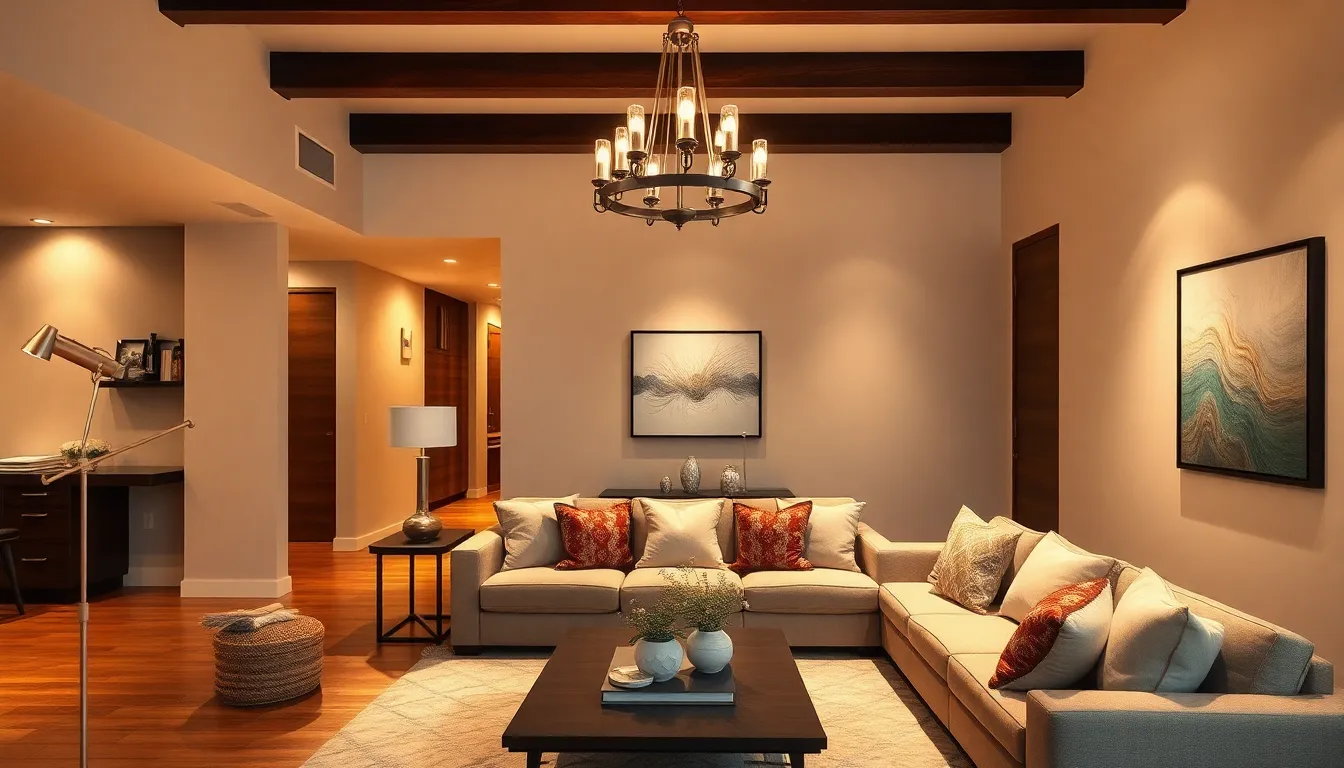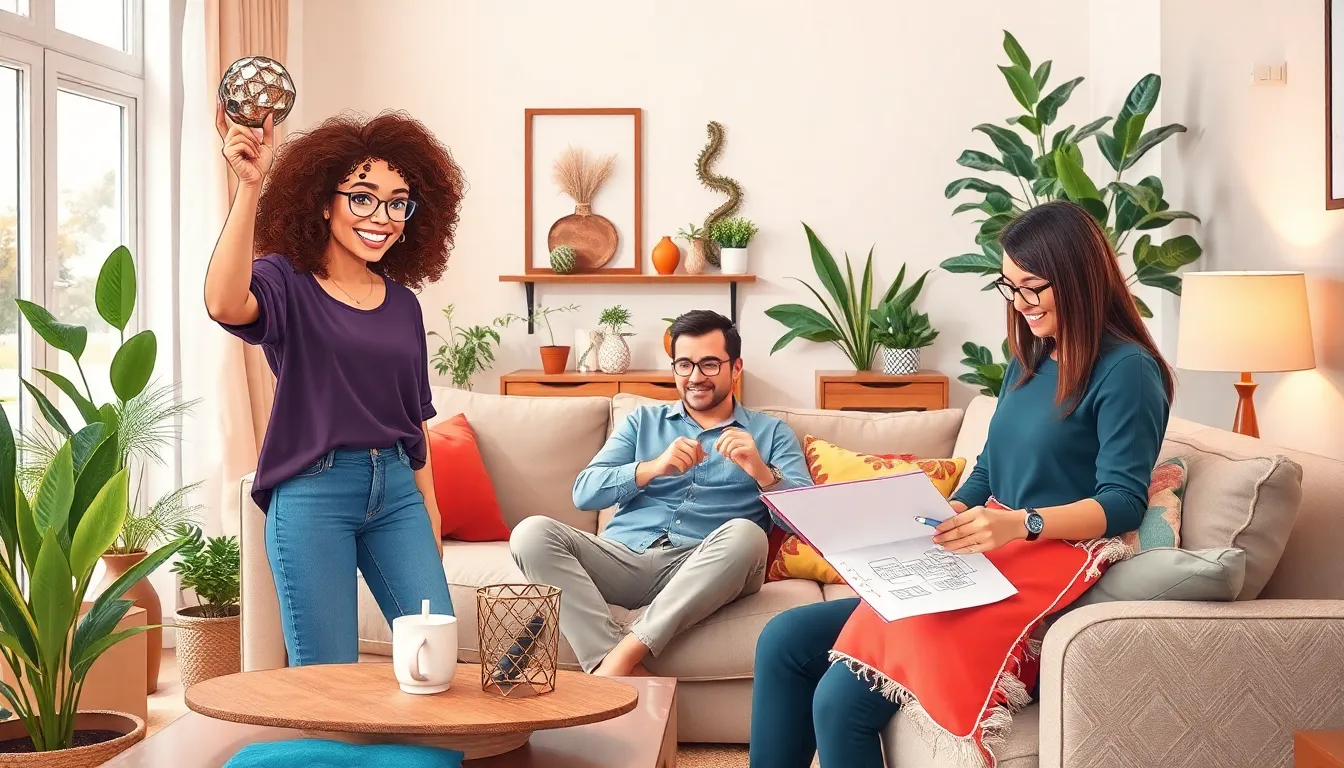Table of Contents
ToggleImagine walking into your home and feeling like you’ve stepped into a cozy café or a chic boutique. That’s the magic of layered home lighting. It’s not just about flipping a switch; it’s about creating an atmosphere that makes you feel right at home. With the right combination of ambient, task, and accent lighting, your space can transform from drab to fab faster than you can say “let there be light!”
Understanding Layered Home Lighting
Layered home lighting creates a multi-dimensional atmosphere that enhances the comfort of any living space. This approach involves combining several types of lighting to brighten and elevate the overall decor.
What Is Layered Home Lighting?
Layered home lighting refers to the strategic use of different lighting types to illuminate a space effectively. Ambient lighting serves as the foundation, providing overall illumination. Task lighting focuses on specific activities, such as reading or cooking. Accent lighting highlights particular features like artwork or architectural details. Utilizing these elements together fosters balance and allows for flexibility in lighting design.
Importance of Layered Lighting
Layered lighting plays a crucial role in enhancing the functionality of a home. It allows homeowners to control the ambiance for various activities and occasions. Adjusting the intensity and type of light can dramatically change the mood of a room. This lighting technique also enhances the aesthetic appeal of space, making it feel more inviting and well-designed. Overall, layered lighting supports both practical needs and decorative goals, ensuring spaces meet diverse requirements.
Types of Layered Home Lighting
Layered home lighting consists of three main types: ambient, task, and accent lighting. Each type plays a unique role in achieving a harmonious and functional space.
Ambient Lighting
Ambient lighting provides the foundation for any room. This general illumination fills the space, ensuring it feels comfortable and inviting. Common sources of ambient lighting include ceiling fixtures, wall sconces, and natural light from windows. Layering this type with warm bulbs promotes a cozy atmosphere. When strategically placed, ambient lights eliminate harsh shadows, enhancing the overall functionality of the environment.
Task Lighting
Task lighting is essential for activities requiring focused illumination. This specific lighting type often comes from desk lamps, under-cabinet lights, or reading lights. Effectively positioned, task lighting boosts productivity, particularly in workspaces and kitchens. By highlighting particular areas, this lighting enhances visibility for tasks like reading or cooking. Homeowners should consider adjustable fixtures to customize brightness levels as tasks change.
Accent Lighting
Accent lighting adds depth and interest to a room. This emphasis on particular features, such as artwork, architectural details, or plants, creates a visually dynamic atmosphere. Examples include spotlights, wall-mounted fixtures, and decorative table lamps. Properly utilized, accent lights draw attention while enhancing the room’s aesthetics. Combining these lights with ambient and task lighting amplifies the space’s character and warmth.
Benefits of Layered Home Lighting
Layered home lighting offers several advantages that enhance both comfort and utility in living spaces.
Improved Functionality
Layered lighting significantly boosts the functionality of a room. Ambient lighting ensures overall illumination, filling the space while task lighting zeroes in on specific activities. Bright desk lamps illuminate workspaces, making tasks like reading or zoning in on tasks much easier. Under-cabinet lights brighten kitchen counters, enhancing cooking experiences. Proper layering allows homeowners to adapt their lighting to various activities, easily transitioning from bright task lighting during the day to soft ambient lighting for evening relaxation.
Enhanced Aesthetics
Layered lighting elevates a home’s visual appeal. Varying light sources create depth, drawing attention to architectural features and decor. Accent lighting highlights artwork, creating a focal point that transforms a simple wall into a gallery. Through thoughtful selection of light fixtures, homeowners can accentuate colors and textures, enhancing the overall design of a room. This careful orchestration of light not only contributes to aesthetic beauty but also fosters an inviting atmosphere for family and guests.
Energy Efficiency
Layered lighting contributes to energy efficiency in multiple ways. By using LED bulbs in fixtures, homeowners can significantly reduce energy consumption compared to traditional incandescent lighting. Task lighting allows individuals to focus on specific areas, minimizing the need for full ambient light. This strategic use of different lighting types can lower overall utility bills while maintaining a comfortable environment. Smart home systems enhance this efficiency by allowing users to control lighting levels and schedules, ensuring lights are on only when needed.
Tips for Implementing Layered Home Lighting
Implementing layered home lighting creates a balanced atmosphere enhancing both comfort and aesthetics. Consider the following guidelines for effective lighting design.
Choosing the Right Fixtures
Selecting the right fixtures is crucial for achieving layered lighting. Ambient lighting can include ceiling-mounted fixtures or wall sconces that evenly distribute light across the room. Task lighting benefits from adjustable desk lamps or under-cabinet fixtures that focus on specific areas. Accent lighting utilizes spotlights or decorative lamps to emphasize artwork or architectural details. Evaluating the space and determining the primary functions will aid in fixture selection. High-quality LEDs enhance energy efficiency while offering the desired brightness.
Layering Techniques for Different Rooms
Different rooms require tailored layering techniques to optimize lighting. Living rooms thrive on ambient lighting from chandeliers along with task lighting from table lamps for reading. Kitchens appreciate a blend of bright task lighting under cabinets and gentle ambient lighting overhead. Bedrooms benefit from layered lighting featuring soft ambient lights combined with bedside lamps for convenience. Bathrooms use overhead lighting alongside task lighting near mirrors. Tailoring lighting types to each room ensures functionality and comfort.
Layered home lighting is a powerful tool for transforming any space into a warm and inviting environment. By thoughtfully combining ambient, task, and accent lighting, homeowners can create a dynamic atmosphere that enhances both functionality and aesthetics. This approach not only elevates the overall decor but also allows for adaptability in mood and purpose throughout the day.
Investing in the right fixtures and techniques tailored to each room can significantly improve comfort and usability. As homeowners embrace layered lighting, they’ll find it fosters a welcoming ambiance for family and guests alike while promoting energy efficiency. Ultimately, layered home lighting is essential for anyone looking to elevate their living space.







